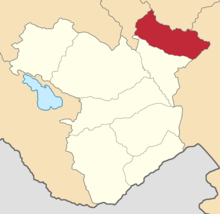Nukha Uyezd
Nukhinsky Uyezd
Нухинский уезд | |
|---|---|
 | |
 | |
| Country | Russia |
| Political status | Uyezd |
| Region | Caucasus |
| Established | 1868 |
| Abolished | 1921 |
| Area | |
| • Total | 4,194 km2 (1,619 sq mi) |
| Population (1916) | |
| • Total | 185,748 |
| • Density | 44/km2 (110/sq mi) |
The Nukha Uyezd (Russian: Нухинский уезд), also transliterated as Nukhinskiy Uyezd, sometimes called Shakinskiy Uyezd, was one of the uyezds (administrative units) of the Elisabethpol Governorate of the Russian Empire and later of the Azerbaijan Democratic Republic with its center in Nukha from 1868 until its formal abolition in 1921 by the Soviet authorities of the Azerbaijan SSR.[1][2]
Geography[]
The Elisabethpol Governorate as a whole consisted of the Elisabethpol, Nukha, Shusha, Zangezur, Kazakh, Aresh, Jebrail, and Jevanshir Uyezds.[3] The Nukha uyezd was located in the far northeastern part of the Elisabethpol Governorate, bordering the Dagestan Oblast to the north, the Baku Governorate to the east, the Zakatala special administrative okrug to the west, and the Aresh Uyezd on the south. The administrative center of the Nukha Uyezd was the city of Nukha. The northern part of the uyezd was largely mountainous and laid along the Greater Caucasus mountain range, where the altitude reaches as high as 14-15 thousand feet in altitude. The notable peaks of the district included Mount Bazardüzü (14,722 ft) and Tkhfan Dag (13,764 ft) whose valleys were enriched with many rivers. The southern part of the region possessed the best conditions for agricultural use including gardening, harvesting rice and sericulture. The main rivers in the Nukha Uyezd were Shin-chay, Kish-chay, Ajighan-chay, Turyanchay, Goychay which were used for irrigation purposes.[2]
History[]
After the establishment of Russian rule over the khanates in the South Caucasus and the implementation of administrative reforms, the territories of the erstwhile Shaki Khanate were incorporated into Shamakhi Governorate of the Russian Empire, later ebing renamed to the Baku Governorate. Upon establishment of the Elisabethpol Governorate in 1868, the Nukha Uyezd was transferred from the Baku to Elisabethpol Governorates.[4] In 1874, the southern section of Nukha Uyezd was separated to form the Aresh Uyezd within the same governorate. On 30 August 1918, the Elisabethpol Governorate was officially renamed to the Ganja Governorate in an effort by the authorities of the Azerbaijan Democratic Republic to de-Russify the region of its Tsarist toponyms.[5]
Demographics[]
Russian Imperial Census of 1897[]
According to census held in 1897, the population of uyezd was 120,555, of which 83,578 were Turko-Tatars (now Azerbaijanis), 18,899 were Armenians, 8,506 - Kyuris, 7,030 - Udis, 1,752 - Tats, 230 - Russians, and other minorities.[6][7] The population was engaged primarily in agricultural farming, gardening, sericulture, tobacco growing.[2] At the end of the 19th century, Nukha Uyezd was making up about 95% of tobacco production of Elisabethpol Governorate.[8]
Caucasian Calendar of 1917[]
The 1917 Caucasian Calendar which produced statistics of 1916 indicates 185,748 residents in the Nukha Uyezd, including 102,423 men and 83,325 women, 182,124 of whom were the permanent population, and 3,624 were temporary residents. The statistics indicated the district to be overwhelmingly Azerbaijani with sizeable Armenian, Udi and Russian minorities, the Udis, however, were not present in the center:[9]
| Area | Russians | Other
Europeans |
Georgians | Armenians | North Caucasians | Other Asian Nationalities | Jews | TOTAL | |||
|---|---|---|---|---|---|---|---|---|---|---|---|
| Orthodox | Sectarian | Christian | Shia Muslim | Sunni Muslim | |||||||
| Nukha | 575 | ... | 7 | ... | 8,009 | 244 | ... | 9,588 | 33,813 | 7 | 52,243 |
| Rural | 1,778 | 53 | ... | 156 | 17,751 | 7,861 | 10,668 | 1,005 | 92,552 | 1,681 | 133,505 |
| TOTAL | 2,353 | 53 | 7 | 156 | 25,760 | 8,105 | 10,668 | 10,593 | 126,365 | 1,688 | 185,748 |
| 1.3% | 0.0% | 0.0% | 0.0% | 13.9% | 4.4% | 5.7% | 5.7% | 68.0% | 0.9% | 100.0% | |
References[]
- ^ Chisholm, Hugh, ed. (1911). . Encyclopædia Britannica. 09 (11th ed.). Cambridge University Press. p. 280.
- ^ a b c "Большой энциклопедический словарь Брокгауза и Ефрона. Нуха" [Brockhaus and Efron Encyclopedia Dictionary. Nukha]. Retrieved 2011-08-09.
- ^ "Административно-территориальные реформы на Кавказе в середине и во второй половине XIX века" [Administrative-territorial reforms in Caucasus in middle and second half of 19th century]. Retrieved 2011-08-09.
- ^ Agaian, Tshatur (1956). Крестьянская реформа в Азербайджане в 1870 году [Peasant reforms in Azerbaijan in 1870]. Baku, Azerbaijan: National Academy of Sciences of Azerbaijan SSR. p. 61.
- ^ Khalafov, M.S. (1964). История государства и права Азербайджанской ССР [History of State and Law of Azerbaijan SSR]. 1. Baku, Azerbaijan: National Academy of Sciences of Azerbaijan SSR. Institute of Philosophy and Law. p. 46.
- ^ "Первая всеобщая перепись населения Российской Империи 1897 г. Распределение населения по родному языку и уездам Российской Империи кроме губерний Европейской России" [First All Russian Imperial Census of 1897. Population split according to languages spoken; uyezds of Russian empire except for governorates in European part of empire]. Retrieved 2011-08-09.
- ^ "НУХИНСКИЙ УЕЗД (1897 г.)" [Nukhinskiy Uyezd (1897)]. Retrieved 2011-08-09.
- ^ Molchanov, Vasily Dmitrievich (1958). Крестьянское хозяйство в Закавказье к концу XIX в [Peasant agriculture in Transcaucasus at the end if 19th century]. Moscow: National Academy of Sciences of USSR. p. 425.
- ^ Кавказский календарь .... на 1917 год (in Russian). pp. 355–358.
- Geographic history of Azerbaijan
- States and territories established in 1868
- 1921 disestablishments
- Uyezds of Elisabethpol Governorate
- Uyezds of the Soviet Union